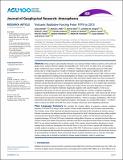Volcanic Radiative Forcing From 1979 to 2015
Author(s)
Schmidt, Anja; Mills, Michael J.; Ghan, Steven; Gregory, Jonathan M.; Allan, Richard P.; Andrews, Timothy; Bardeen, Charles G.; Conley, Andrew; Forster, Piers M.; Gettelman, Andrew; Portmann, Robert W.; Solomon, Susan; Toon, Owen B.; ... Show more Show less
DownloadSolomon 1 Schmidt2018supportinginfo.pdf (2.472Mb)
Terms of use
Metadata
Show full item recordAbstract
Using volcanic sulfur dioxide emissions in an aerosol‐climate model, we derive a time series of global‐mean volcanic effective radiative forcing (ERF) from 1979 to 2015. For 2005–2015, we calculate a global multiannual mean volcanic ERF of −0.08 W/m2 relative to the volcanically quiescent 1999–2002 period, due to a high frequency of small‐to‐moderate‐magnitude explosive eruptions after 2004. For eruptions of large magnitude such as 1991 Mt. Pinatubo, our model‐simulated volcanic ERF, which accounts for rapid adjustments including aerosol perturbations of clouds, is less negative than that reported in the Intergovernmental Panel on Climate Change (IPCC) Fifth Assessment Report (AR5) that only accounted for stratospheric temperature adjustments. We find that, when rapid adjustments are considered, the relation between volcanic forcing and volcanic stratospheric optical depth (SAOD) is 13–21% weaker than reported in IPCC AR5 for large‐magnitude eruptions. Further, our analysis of the recurrence frequency of eruptions reveals that sulfur‐rich small‐to‐moderate‐magnitude eruptions with column heights ≥10 km occur frequently, with periods of volcanic quiescence being statistically rare. Small‐to‐moderate‐magnitude eruptions should therefore be included in climate model simulations, given the >50% chance of one or two eruptions to occur in any given year. Not all of these eruptions affect the stratospheric aerosol budget, but those that do increase the nonvolcanic background SAOD by ~0.004 on average, contributing ~50% to the total SAOD in the absence of large‐magnitude eruptions. This equates to a volcanic ERF of about −0.10 W/m², which is about two thirds of the ERF from ozone changes induced by ozone‐depleting substances. Keywords: volcanic eruptions; volcanic radiative forcing; aerosol-cloud interactions; volcanic aerosol; volcanic emissions; climate change
Date issued
2018-12Department
Massachusetts Institute of Technology. Department of Earth, Atmospheric, and Planetary SciencesJournal
Journal of Geophysical Research: Atmospheres
Publisher
American Geophysical Union (AGU)
Citation
Schmidt, Anja et al. “Volcanic Radiative Forcing From 1979 to 2015.” Journal of Geophysical Research: Atmospheres 123, 22 (November 2018): 12,491–12,508 © 2018 American Geophysical Union
Version: Final published version
ISSN
2169-897X
2169-8996